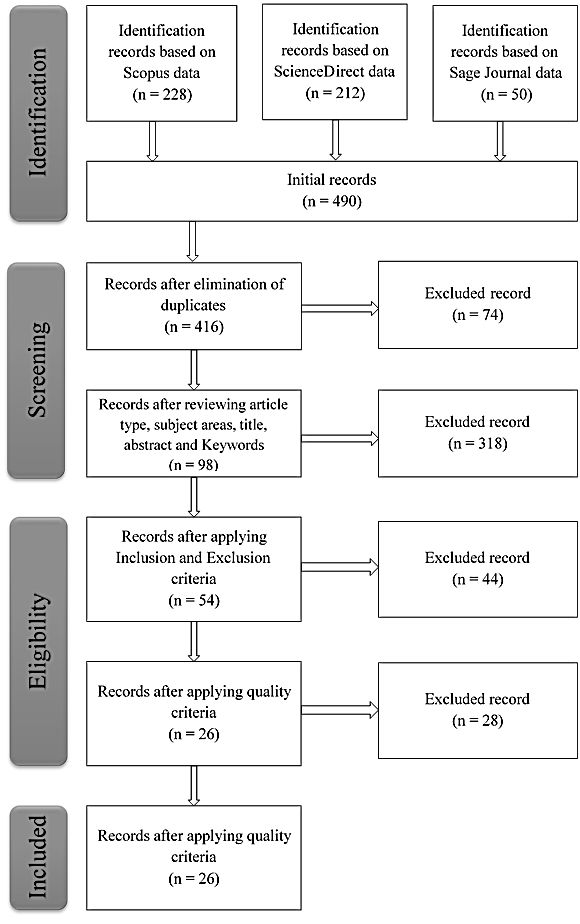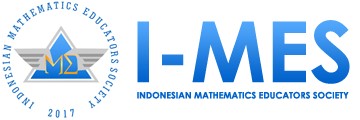Implementation of virtual reality to enhance spatial abilities: a study on aspects, effects, and differences in participants' initial ability levels
DOI:
https://doi.org/10.33830/ijdmde.v1i2.9108Keywords:
Virtual reality (VR), Spatial abilities, Mathematics learning, Systematic literature review (SLR)Abstract
This research is important because the development of Virtual Reality (VR) technology has shown significant potential in enhancing spatial abilities, which are crucial aspects of education and training across various fields. This study aims to identify and evaluate the extent to which VR can enhance spatial abilities and determine the factors that influence the adoption of VR in educational contexts. The specific target is to identify at least three main factors affecting the effectiveness of VR in improving spatial abilities and to evaluate its impact on differences in students' initial abilities. The research method used is a Systematic Literature Review (SLR), which involves identifying, evaluating, and interpreting all relevant research that answers specific research questions. Data were collected from three major databases: Scopus, ScienceDirect, and Sage Journal, covering 2013 to 2022. This study focuses on considerations for using VR, its impact on differences in initial spatial abilities, and the various aspects of spatial abilities affected by VR intervention. The results from the 26 studies reviewed indicate that the use of VR technology in learning can enhance spatial abilities, with the most studied aspect being mental rotation. Additionally, VR has a greater impact on participants with a low spatial ability background. From an affective aspect, the use of VR significantly influences participants' motivation and interest, attributed to the realistic and interactive effects perceived. The implications of this research provide important contributions for researchers and educational practitioners to develop more effective interventions in enhancing spatial abilities in the future.
References
Anggriawan, B., Effendy, E., & Budiasih, E. (2017). Kemampuan Spasial dan Kaitanya dengan pemahaman mahasiswa terhadap materi simetri. Jurnal Pendidikan: Teori, Penelitian, Dan Pengembangan, 2(12), 1612–1619. https://doi.org/10.17977/JPTPP.V2I12.10299
Atit, K., Power, J. R., Pigott, T., Lee, J., Geer, E. A., Uttal, D. H., Ganley, C. M., & Sorby, S. A. (2021). Examining the relations between spatial skills and mathematical performance: A meta-analysis. Psychonomic Bulletin & Review 2021 29:3, 29(3), 699–720. https://doi.org/10.3758/S13423-021-02012-W
Bailey, J. O., & Bailenson, J. N. (2017). Immersive virtual reality and the developing child. In Cognitive development in digital contexts (pp. 181-200). Academic Press.
Bamodu, O., & Ye, X. M. (2013). Virtual reality and virtual reality system components. Advanced Materials Research, 765, 1169–1172. https://doi.org/10.2991/icsem.2013.192
Bhagat, K. K., & Chang, C.-Y. (2015). Incorporating GeoGebra into Geometry Learning lesson from India. Eurasia Journal of Mathematics, Science and Technology Education, 11(1), 77–86. https://doi.org/10.12973/eurasia.2015.1307a
Cangas, D., Codina, A., Chavil, D. I., Fernández, J. M., García, M. M., Kamerling, J., López, E., Morga, G., Rodríguez, J. L., & Romero, I. M. (2021). Using notice VR for stem education in virtual reality. Conference Proceedings. The Future of Education 2021.
Carroll, J. B. (1993). Human cognitive abilities: A survey of factor-analytic studies (Issue 1). Cambridge University Press.
Chakareski, J., Corbillon, X., Simon, G., & Swaminathan, V. (2022). User Navigation Modeling, Rate-Distortion Analysis, and End-to-End Optimization for Viewport-Driven 360$^circ $ Video Streaming. IEEE Transactions on Multimedia, 25, 5941–5956. https://doi.org/10.1109/TMM.2022.3201397
Chandrasekera, T., Yoon, S.-Y., & D’Souza, N. (2015). Virtual environments with soundscapes: a study on immersion and effects of spatial abilities. Environment and Planning B: Planning and Design, 42(6), 1003–1019. https://doi.org/10.1068/b130087p
Chao, W.-H., & Chang, R.-C. (2020). The impact of applying virtual reality technology to spatial ability learning in elementary school students. International Conference on Innovative Technologies and Learning, 137–144. https://doi.org/0.1007/978-3-030-63885-6_16
Conde, M. Á., Sedano, F. J. R., Fernández-Llamas, C., Gonçalves, J., Lima, J., & García-Peñalvo, F. J. (2020). RoboSTEAM project systematic mapping: Challenge-based learning and robotics. 2020 IEEE Global Engineering Education Conference (EDUCON), 214–221. https://doi.org/10.1109/EDUCON45650.2020.9125103
de Back, T. T., Tinga, A. M., Nguyen, P., & Louwerse, M. M. (2020). Benefits of immersive collaborative learning in CAVE-based virtual reality. International Journal of Educational Technology in Higher Education, 17(1). https://doi.org/10.1186/s41239-020-00228-9
Fuys, D. (1984). English Translation of Selected Writings of Dina van Hiele-Geldof and Pierre M. van Hiele. https://files.eric.ed.gov/fulltext/ED287697.pdf
Gardner, H. (1993). Multiple intelligences: The theory in practice. Basic Books/Hachette Book Group.
Giakis, T., Koufaki, I., Metaxa, M., Sideridou, A., Thymniou, A., Arfaras, G., Antoniou, P., & Bamidis, P. (2019). Enhancing spatial ability through a virtual reality game for primary school children: “The wizard of upside down”: An experimental approach. Communications in Computer and Information Science, 993, 519–528. https://doi.org/10.1007/978-3-030-20954-4_39/FIGURES/10
González, N. A. A. (2018). Development of spatial skills with virtual reality and augmented reality. International Journal on Interactive Design and Manufacturing (IJIDeM), 12, 133–144. https://doi.org/10.1007/s12008-017-0388-x
Gutiérrez, J. M., Domínguez, M. G., & González, C. R. (2015). Using 3D virtual technologies to train spatial skills in engineering. International Journal of Engineering Education, 31(1), 323–334.
Guzsvinecz, T., Orban-Mihalyko, E., Sik-Lanyi, C., & Perge, E. (2022). An Overview of Received Results on MRT, MCT, and PSVT Spatial Ability Tests in Virtual Environments. 1st IEEE International Conference on Internet of Digital Reality, IoD 2022, 83–88. https://doi.org/10.1109/IoD55468.2022.9987064
Hawes, Z., Moss, J., Caswell, B., Seo, J., & Ansari, D. (2019). Relations between numerical, spatial, and executive function skills and mathematics achievement: A latent-variable approach. Cognitive Psychology, 109, 68–90. https://doi.org/ 10.1016/j.cogpsych.2018.12.002
Hong, J.-C., Hwang, M.-Y., Tai, K.-H., Tsai, C.-R., & Australia, C. S. U. D. S. et al. ; I. E. S. I. N. S. W. S. U. of W. (2019). Training Spatial Ability through Virtual Reality. In M. J. W. Lee, S. Nikolic, G. K. W. Wong, J. Shen, M. Ros, L. C. U. Lei, & N. Venkatarayalu (Eds.), 2018 IEEE International Conference on Teaching, Assessment, and Learning for Engineering, TALE 2018 (pp. 1204–1205). Institute of Electrical and Electronics Engineers Inc. https://doi.org/10.1109/TALE.2018.8615333
Jang, S., Vitale, J. M., Jyung, R. W., & Black, J. B. (2017). Direct manipulation is better than passive viewing for learning anatomy in a three-dimensional virtual reality environment. Computers and Education, 106, 150–165. https://doi.org/10.1016/j.compedu.2016.12.009
Johnson, S. P., & Moore, D. S. (2020). Spatial thinking in infancy: Origins and development of mental rotation between 3 and 10 months of age. Cognitive Research: Principles and Implications, 5(1), 10. https://doi.org/10.1186/s41235-020-00212-x
Kimura, K., Reichert, J. F., Kelly, D. M., & Moussavi, Z. (2019). Older adults show less flexible spatial cue use when navigating in a virtual reality environment compared with younger adults. Neuroscience Insights, 14, 2633105519896803. https://doi.org/ 10.1177/2633105519896803
Lee, E. A.-L., & Wong, K. W. (2014). Learning with desktop virtual reality: Low spatial ability learners are more positively affected. Computers and Education, 79, 49–58. https://doi.org/10.1016/j.compedu.2014.07.010
Lochhead, I., Hedley, N., Çöltekin, A., & Fisher, B. (2022). The immersive mental rotations test: Evaluating spatial ability in virtual reality. Frontiers in Virtual Reality, 3, 820237. https://doi.org/10.3389/frvir.2022.820237
Lohman, D. F., Pellegrino, J. W., Alderton, D. L., & Regian, J. W. (1987). Dimensions and components of individual differences in spatial abilities. In Intelligence and cognition: Contemporary frames of reference (pp. 253–312). Springer.
Lu, J., Seavey, L., Zuk, S., Dimino, J., & Martin, F. (2022). Evaluating Student Spatial Skills Learning in a Virtual Reality Programming Environment. 2022 IEEE Frontiers in Education Conference, FIE 2022, 2022-October. https://doi.org/10.1109/FIE56618.2022.9962403
Martin-Gutiérrez, J., Garcia-Dominguez, M., González, C. R., Corredeguas, M. C. M., & Society, I. of E. and E. E. (IEEE) C. S. A. S. for E. E. (ASEE)-; E. R. M. (ERM) D. I. of E. and E. E. (IEEE) E. (2013). Using different methodologies and technologies to training spatial skill in Engineering Graphic subjects. 43rd IEEE Annual Frontiers in Education Conference, FIE 2013, 362–368. https://doi.org/10.1109/FIE.2013.6684848
Meng, F., Zhang, W., & Yang, R. (2014). The development of a panorama manifestation virtual reality system for navigation and a usability comparison with a desktop system. Behaviour and Information Technology, 33(2), 133–143. https://doi.org/10.1080/0144929X.2013.857432
Merchant, Z., Goetz, E. T., Keeney-Kennicutt, W., Cifuentes, L., Kwok, O., & Davis, T. J. (2013). Exploring 3-D virtual reality technology for spatial ability and chemistry achievement. Journal of Computer Assisted Learning, 29(6), 579–590. https://doi.org/10.1111/jcal.12018
Molina-Carmona, R., Pertegal-Felices, M. L., Jimeno-Morenilla, A., & Mora-Mora, H. (2018). Assessing the Impact of Virtual Reality on Engineering Students’ Spatial Ability. In The Future of Innovation and Technology in Education: Policies and Practices for Teaching and Learning Excellence (pp. 171–185). Emerald Group Publishing Ltd. https://doi.org/10.1108/978-1-78756-555-520181013
Obeid, S., & Demirkan, H. (2020). The influence of virtual reality on design process creativity in basic design studios. Interactive Learning Environments. https://doi.org/10.1080/10494820.2020.1858116
Onyancha, R. M., Derov, M., & Kinsey, B. L. (2009). Improvements in spatial ability as a result of targeted training and computer‐aided design software use: Analyses of object geometries and rotation types. Journal of Engineering Education, 98(2), 157–167.
Pellegrino, J. W., Alderton, D. L., & Shute, V. J. (1984). Understanding spatial ability. Educational Psychologist, 19(4), 239–253.
Petersen, K., Vakkalanka, S., & Kuzniarz, L. (2015). Guidelines for conducting systematic mapping studies in software engineering: An update. Information and Software Technology, 64, 1–18. https://doi.org/10.1016/j.infsof.2015.03.007
Qin, H., Liu, B., & Wang, D. (2015). The impact of time pressure on spatial ability in virtual reality. Virtual, Augmented and Mixed Reality: 7th International Conference, VAMR 2015, Held as Part of HCI International 2015, Los Angeles, CA, USA, August 2-7, 2015, Proceedings 7, 60–66.
Roca-González, C., Martin-Gutierrez, J., García-Dominguez, M., & Carrodeguas, M. C. N. (2017). Virtual technologies to develop visual-spatial ability in engineering students. Eurasia Journal of Mathematics, Science and Technology Education, 13(2), 441–468. https://doi.org/10.12973/eurasia.2017.00625a
Rodríguez, J. L. (2022). Exploring dynamic geometry through immersive virtual reality and distance teaching. In Mathematics Education in the Age of Artificial Intelligence: How Artificial Intelligence can Serve Mathematical Human Learning (pp. 343–363). Springer.
Rodríguez, J. L., Morga, G., & Cangas-Moldes, D. (2019). Geometry teaching experience in virtual reality with NeoTrie VR. Psychology, Society & Education, 11(3), 355–366. https://doi.org/10.21071/PSYE.V11I3.13951
Shepard, R. N., & Metzler, J. (1971). Mental rotation of three-dimensional objects. Science, 171(3972), 701–703.
Sudirman, S., & Alghadari, F. (2020). Bagaimana Mengembangkan Kemampuan Spasial dalam Pembelajaran Matematika di Sekolah?: Suatu Tinjauan Literatur. Journal of Instructional Mathematics, 1(2), 60-72. https://doi.org/10.37640/jim.v1i2.370
Supriadi, S., Wildan, W., Hakim, A., Savalas, L. R. T., & Haris, M. (2021). Model mental dan kemampuan spasial mahasiswa tahun pertama dan ketiga pendidikan kimia di Universitas Mataram. Jurnal Pijar Mipa, 16(3), 282–287.https://doi.org/10.29303/jpm.v16i3.1366
Vidermanova, K., & Vallo, D. (2015). Practical geometry tasks as a method for teaching active learning in geometry. Procedia-Social and Behavioral Sciences, 191, 1796–1800.
Weng, C., Rathinasabapathi, A., Weng, A., & Zagita, C. (2019). Mixed Reality in Science Education as a Learning Support: A Revitalized Science Book. Journal of Educational Computing Research, 57(3), 777–807. https://doi.org/10.1177/0735633118757017
West, R. L., Morris, C. W., & Nichol, G. T. (2013). Spatial cognition on nonspatial tasks: Finding spatial knowledge when you’re not looking for it. In The development of spatial cognition (pp. 13–39). Psychology Press.
Wong, J., Yu, K., & Giacaman, N. (2021). Scaffolding spatial ability with augmented reality and virtual reality. International Journal of Mobile Learning and Organisation, 15(1), 50–70. https://doi.org/10.1504/IJMLO.2021.111597
Yang, Y., Conners, F. A., & Merrill, E. C. (2014). Visuo-spatial ability in individuals with Down syndrome: Is it really a strength? Research in Developmental Disabilities, 35(7), 1473–1500. https://doi.org/10.1016/j.ridd.2014.04.002
Yilmaz, R. M., Baydas, O., Karakus, T., & Goktas, Y. (2015). An examination of interactions in a three-dimensional virtual world. Computers and Education, 88, 256–267. https://doi.org/10.1016/j.compedu.2015.06.002
Zhou, Y., Xu, T., Yang, H., & Li, S. (2022). Improving Spatial Visualization and Mental Rotation Using FORSpatial Through Shapes and Letters in Virtual Environment. IEEE Transactions on Learning Technologies, 15(3), 326–337. https://doi.org/10.1109/TLT.2022.3170928

Downloads
Published
How to Cite
Issue
Section
License
Copyright (c) 2024 Samsul Pahmi, Asllan Vrapi, Edi Supriyadi

This work is licensed under a Creative Commons Attribution-ShareAlike 4.0 International License.












